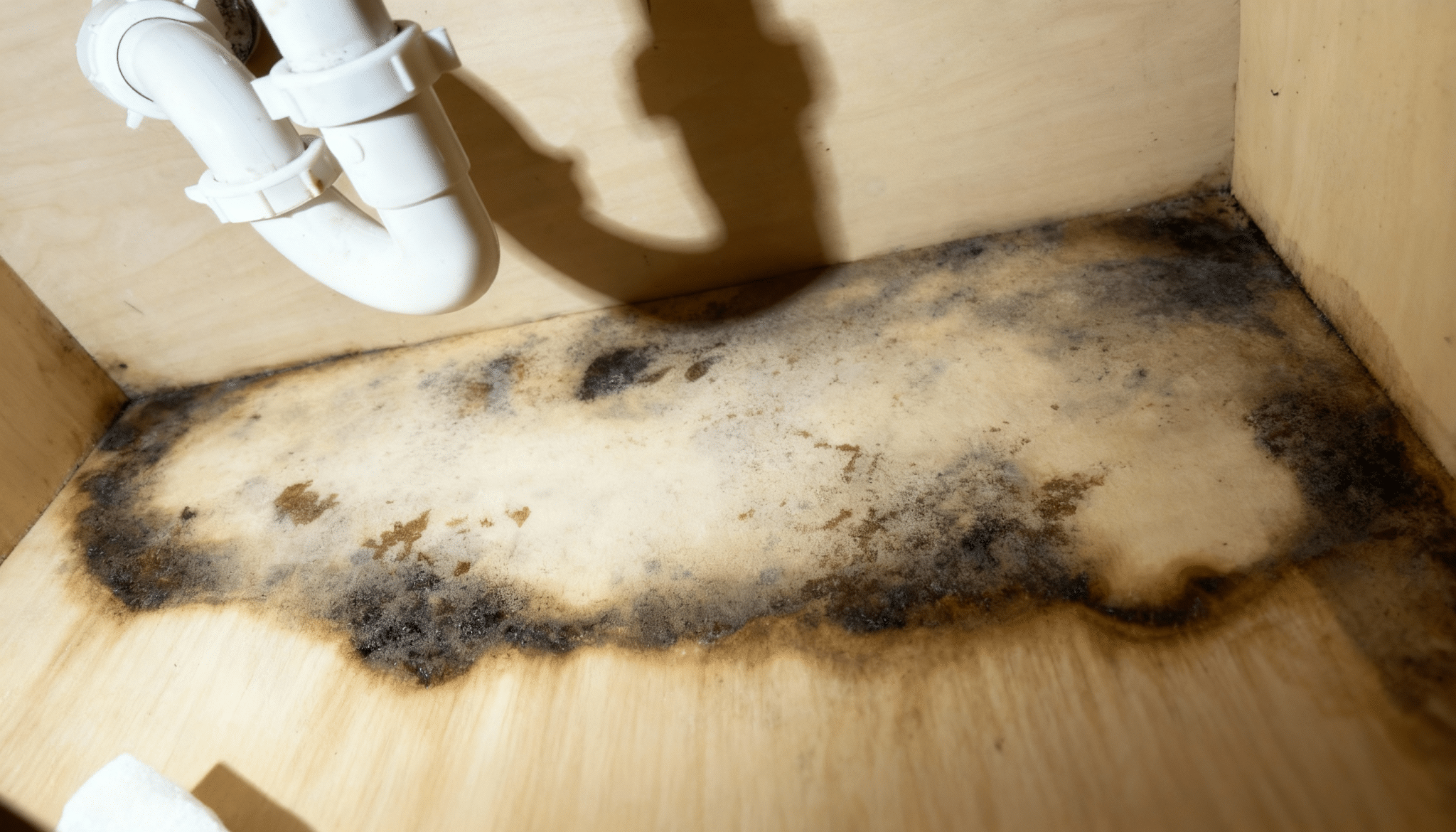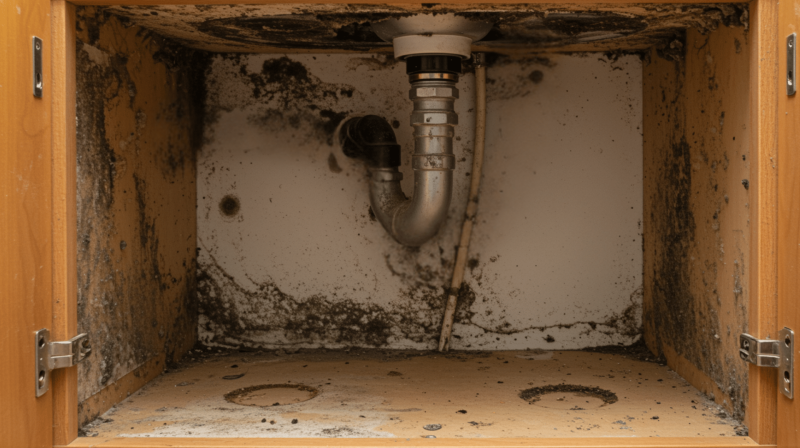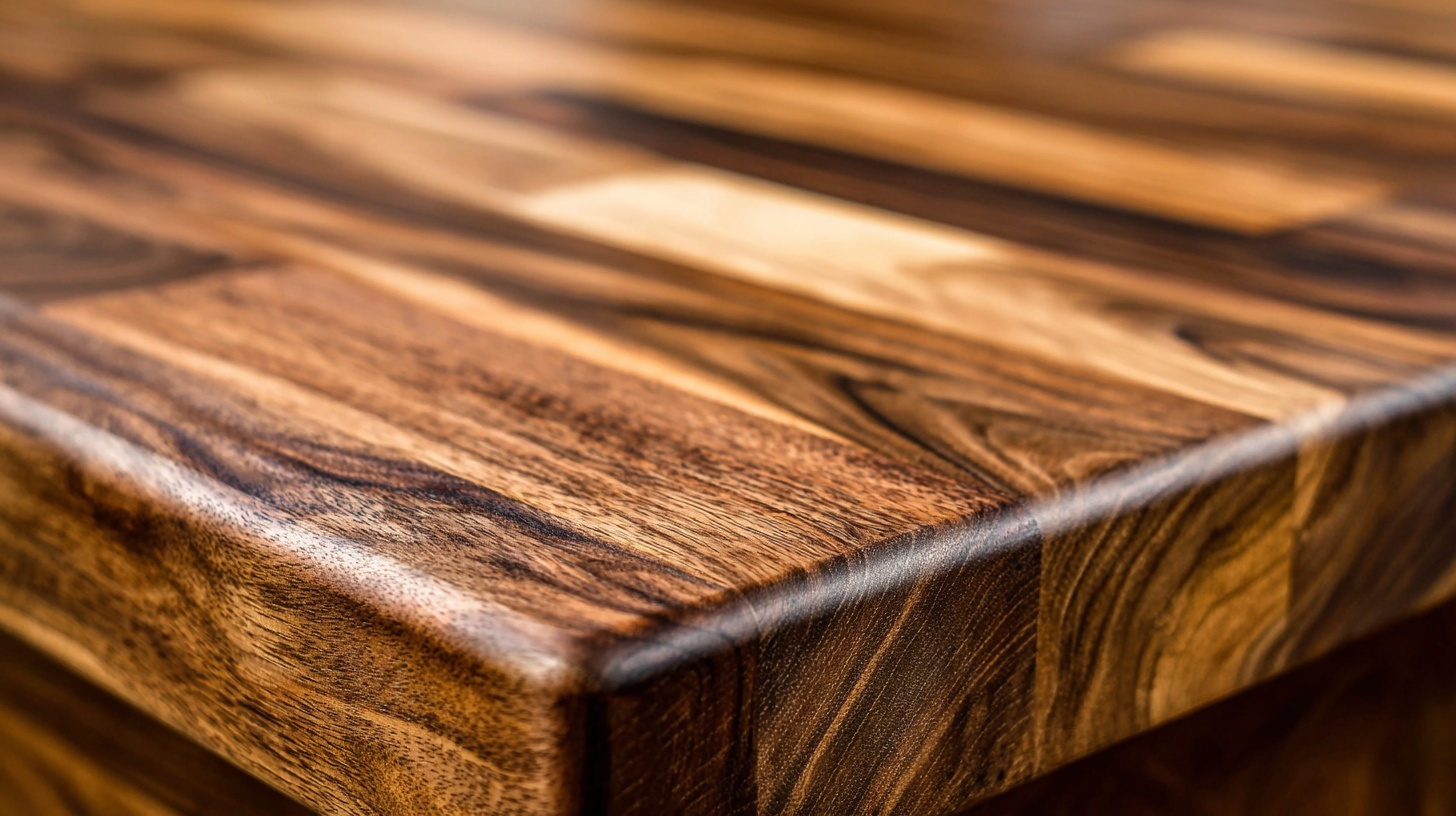That black or green stuff spreading under your kitchen sink isn’t just ugly; it could be making your family sick.
Mold under the kitchen sink releases spores into the air you breathe, and your kitchen sink cabinet creates the perfect environment for it to thrive.
In this blog, I’ll walk you through identifying mold, removing it properly, and preventing future growth. Let’s fix this problem together.
Causes of Mold Under the Kitchen Sink
Before you start scrubbing, it helps to understand why mold keeps showing up in that cabinet.
Once you know what’s feeding it, you can stop the problem at its source and keep your space clean for good.
1. Leaking Pipes
Dripping pipes create constant moisture that mold absolutely loves. Even a tiny leak you can barely see will soak into wood surfaces and create the perfect breeding ground.
Check all your connections, including the garbage disposal and dishwasher lines. That slow drip might seem harmless, but it’s feeding colonies of spores every single day.
2. Poor Ventilation
That cabinet stays closed most of the time, which means air can’t circulate properly. Humidity gets trapped inside with nowhere to go.
Without fresh air moving through, any moisture that builds up just sits there and creates ideal conditions.
Opening the cabinet doors occasionally helps, but it’s often not enough to solve the problem completely.
3. High Humidity Levels
Your kitchen produces tons of moisture from cooking, running hot water, and using the dishwasher.
All that humidity settles into enclosed spaces like the cabinet under your sink.
During the summer months or in naturally humid climates, this problem gets even worse. The wood and other surfaces stay damp for hours, giving mold plenty of time to grow.
4. Condensation on Pipes
Cold water pipes collect condensation just like a glass of iced tea on a hot day. Those water droplets run down the pipes and pool at the bottom of your cabinet.
Over time, this constant dampness soaks into cabinet floors and walls. You might not notice it happening, but mold certainly does and takes full advantage of it.
5. Stored Wet Items
Tossing damp sponges, wet dish towels, or cleaning rags under the sink seems convenient. But those items hold moisture and never fully dry in that dark space.
They become mold magnets. Even spray bottles and cleaning products can leave wet residue on surfaces.
Everything you store down there affects the overall moisture level inside that cabinet.
How to Recognize Mold

Spotting mold early makes cleaning much easier, so check the mold under the kitchen sink regularly. Mold typically shows up as fuzzy patches in black, green, white, or even orange colors.
You’ll notice a musty, earthy smell that hits you when you open the cabinet door. Look closely at corners, along pipe joints, and on the cabinet floor where moisture tends to collect
Sometimes mold hides behind stored items or grows on the back wall where you can’t easily see it. Run your hand along surfaces to feel for dampness or slippery spots.
If you see discoloration on wood or notice the cabinet floor feels soft, that’s a red flag that mold has been growing for a while.
Steps to Clean Mold Under the Kitchen Sink

Mold under the kitchen sink can spread fast if not handled properly. It often appears because of leaks or dampness in dark corners.
Cleaning it safely requires care, patience, and the right materials.
The following is how I usually deal with it step by step.
1. Gather the Right Cleaning Supplies
Before getting started, make sure to have everything ready. Gloves, goggles, and a mask keep me protected.
I also set out vinegar or hydrogen peroxide as cleaners, a scrub brush, warm water, disposable towels, and trash bags.
Having plastic sheeting nearby helps cover and contain the area. Preparation keeps the cleanup organized and safe.
2. Identify and Contain the Mold Area
I inspect the space thoroughly to see how far the mold has spread. Cabinets, walls, and plumbing fixtures all get checked.
If the mold covers only a small section, I clean it myself, but for large growth, contact professionals. Seal off the area with plastic sheets to prevent spores from spreading while cleaning.
3. Fix the Source of Moisture
Mold keeps coming back unless the dampness issue is solved. I look for leaks in pipes and tighten loose fittings. If condensation is the problem, wrap the pipes to prevent water buildup.
I also reseal sink edges with caulk where needed. This step is crucial for lasting results.
4. Remove Any Contaminated Materials
If the mold has soaked into wood or drywall, I cut out the damaged pieces carefully.
Using sealed bags, throw away anything that can’t be saved.
All debris gets disposed of immediately to avoid spores spreading. Keeping the space clean helps limit future mold growth under the sink.
5. Clean and Dry the Area Thoroughly
Once everything else is done, I spray the surface with my chosen cleaning solution and let it sit for about 15 minutes.
Then I scrub hard surfaces like pipes and shelves until all visible mold is gone. Finally, I rinse with warm water and dry the spot completely with towels or a fan.
Health Issues Caused by Mold
Mold isn’t just gross to look at. It can actually make you and your family sick. The spores float through the air every time you open that cabinet, and you breathe them in without even realizing it.
Respiratory Problems
Mold spores irritate your lungs and airways when you inhale them. You might develop a persistent cough that won’t go away, or feel like you can’t take a deep breath.
Wheezing and chest tightness are common complaints. People with asthma find their symptoms get worse, and attacks happen more frequently when mold is present in the home.
Allergic Reactions
Your body treats mold spores like invaders, triggering allergic responses. Sneezing fits start happening more often, especially in the kitchen.
Your eyes get red, itchy, and watery for no apparent reason. Skin rashes can break out on exposed areas. Some people develop a runny or stuffy nose that feels like a cold that never quite goes away.
Headaches and Fatigue
Constant mold exposure leaves you feeling drained and exhausted even after a full night’s sleep. Headaches pop up regularly, sometimes turning into painful migraines.
You might notice brain fog, making it hard to concentrate or remember things. These symptoms often improve when you spend time away from home, which is a telltale sign that mold is the culprit.
Immune System Weakness
Living with mold puts stress on your immune system as it constantly fights off spores. You’ll catch colds and infections more easily than usual.
Minor illnesses take longer to clear up. Children and elderly family members face even greater risks because their immune systems are more vulnerable.
Severe Reactions in Sensitive Individuals
People with mold allergies or compromised immune systems can experience serious health issues. Black mold, in particular, produces toxins that cause nausea, vomiting, and nosebleeds.
Some folks develop lung infections that require medical treatment.
If anyone in your household has chronic respiratory conditions or autoimmune diseases, mold becomes an even more urgent problem to address immediately.
The Differences Between Mold and Mildew
People often use these terms interchangeably, but mold and mildew are actually different fungi.
Knowing which one you’re dealing with helps you choose the right cleaning approach and understand how serious the problem might be.
| Aspect | Mold | Mildew |
|---|---|---|
| Appearance | Fuzzy or slimy texture with irregular patches | Flat, powdery surface that looks dusty |
| Color | Black, green, red, or blue shades | White, gray, or yellow tones |
| Growth Pattern | Grows deep into surfaces and materials | Stays on the surface, easier to spot |
| Health Risk | Can cause serious respiratory issues and infections | Generally causes milder allergic reactions |
| Removal Difficulty | Requires thorough cleaning, sometimes professional help | Wipes away easily with basic cleaners |
| Damage Potential | Destroys wood, drywall, and other structural materials | Minimal damage, mostly cosmetic issues |
| Smell | Strong, musty odor that’s hard to ignore | Milder smell, less pungent than mold |
| Common Locations | Hidden areas like behind walls, under floors | Visible spots like shower tiles, windowsills |
When To Call a Professional
Sometimes mold problems are bigger than a DIY project can handle. If the mold covers more than ten square feet, you need professional help.
Black mold requires experts who have proper safety equipment and training. When mold keeps coming back despite your cleaning efforts, that signals a deeper moisture issue you can’t see.
Structural damage to cabinet floors or walls means the problem has spread too far.
If anyone in your home develops severe health symptoms like breathing difficulties or persistent infections, call a mold remediation specialist immediately.
Preventive Tips
Cleaning mold is one thing, but keeping it from coming back is where the real victory happens.
A few simple habits will keep that cabinet dry, fresh, and mold-free for the long haul.
- Fix leaks immediately: Don’t wait to repair dripping pipes. Even small leaks create enough moisture for mold to grow.
- Wipe up spills right away: Dry any water splashes under the sink immediately. Keep a towel handy for quick cleanups.
- Install a dehumidifier nearby: A small dehumidifier pulls excess moisture from the air and prevents condensation in closed cabinets.
- Leave cabinet doors open occasionally: Let fresh air circulate for a few hours each week, especially after cooking or running the dishwasher.
- Use moisture absorbers: Place silica gel packets or activated charcoal in the cabinet to soak up excess humidity.
- Insulate cold water pipes: Wrap foam insulation around pipes that sweat to prevent water droplets from dripping.
- Store items properly: Never put wet sponges or damp rags under the sink. Let everything dry completely first.
Wrapping It Up
You’ve got all the information you need now to tackle the problem head-on and keep it from returning.
Remember, the key is catching it early and addressing moisture issues right away.
Don’t let mold take over your kitchen. A little regular maintenance goes a long way in keeping that cabinet clean and your family healthy.
Check for leaks monthly, wipe up spills immediately, and let air circulate through the space.
Got questions or want to share your own mold-fighting tips? Drop a comment below, I’d love to hear what worked for you.







